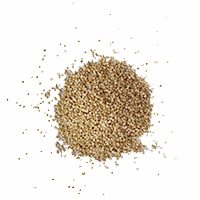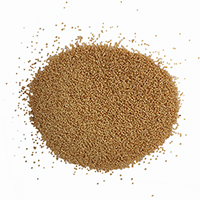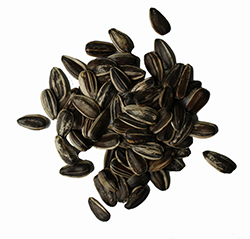
PULSES & CEREALS
The dried vegetables are an excellent source of protein and energy power with a low-fat, an essential element for a healthy and balanced diet to ensure well-being and physical fitness.


CHICKPEAS Cicer Aretinum – Chickpeas, native to the East, were one of the first foods eaten by humans. Today they are widespread in the Middle East and India, where they are one of the main elements in people’s diets. They are suitable for tasty soups, with pasta, as a side dish or paste. Nutritional values are reported in the section “Nutritional Values”. Di Nunzio chickpeas are cultivated in Puglia, in the region of the upper Tavoliere della Daunia, mainly in the area around the town of San Paolo di Civitate. The range is complemented by chickpeas grown in Mexico by leading local farms. We offer the following varieties of chickpeas:



BROAD BEANS Vicia Faba – Broad beans originate from an ancient plant native to Persia or Northern Africa; evidence of their use can be traced back to the Bronze Age and the Iron Age: they represent the first pulses eaten by humans. They’re a typical product of rural Italy. In ancient times they were used not only as a pulse, but made into flour and used to prepare bread, focaccia and polenta. There are literary works dating back to the beginning of the 19th Century (for example “La Fisica Appula” by the Grey Friar Michelangelo Manicone, 1806) testifying that the territory of San Paolo di Civitate is particularly suited to growing broad beans. Today they still are a widely used and versatile pulse, suitable for use in the preparation of several dishes. Nutritional values are reported in the section “Nutritional Values”. Di Nunzio broad beans are cultivated in Puglia, in the region of the upper Tavoliere della Daunia, mainly in the area around the town of San Paolo di Civitate. We offer the following varieties of broad beans:



GRASS PEAS Lathyrus sativus – Grass pea is a difficult pulse to find nowadays which is only grown in small quantities in some regions of central Italy. It grows from the Lathyrus Sativus, an annual plant that looks like the vetch; the seeds in its pods are a little bigger than peas, yet flatter. The Giant White Grass Pea of San Paolo, already used by ancient Romans (cicercula), differs from other varieties grown in Italy in its size, light colour, unique and rounded taste and ease to cook. Nutritional values are reported in the section “Nutritional Values”. Di Nunzio grass peas are cultivated in Puglia, in the region of the upper Tavoliere della Daunia, mainly in the area around the town of San Paolo di Civitate. We offer the following varieties of grass peas:



PEAS Pisum Sativum – Since ancient times peas have always represented a source of nourishment for all populations and, together with beans, were among the most eaten foods. Peas grew spontaneously 9,750 years before the Christian era; grown peas originated in China, but were also grown by ancient Greeks and Romans, who introduced them all over Europe after their occupation. In the UK they were used as money to pay wages to the poor in the Middle Age, in France they were a staple food. Peas are excellent in the fight against obesity due to their ability to satisfy hunger for a long time, especially when eaten as main dish together with rice or pasta, followed by raw or cooked vegetables. They are also excellent in purees and creams, even if their fibrous content is reduced by preparing them in this way. They go well with chicken, sauteed with meat, lard and in soups. Nutritional values are reported in the section “Nutritional Values”. Di Nunzio peas are cultivated in Puglia, in the region of the upper Tavoliere della Daunia, mainly in the area around the town of San Paolo di Civitate. The range is complemented by peas cultivated in Canada and in the Netherlands by leading local farms. We offer the following varieties of peas:



LUPINS Lupinus – Lupins, native to the Mediterranean basin and known to the ancient Romans, come in different varieties; among them, the white lupin, which grows in Italy, is the most common. Lupins, grown mainly in southern Italy, are rich in protein, starches and sugars, iron, calcium, phosphorous and B-group vitamins. They have a high hypoglycemic power. Lupins can only be eaten after a long period of soaking, about 3-4 days with the water changed every 12 hours, then after boiling for 20 minutes boiling to eliminate an alkaloid (lupinin) that gives lupins a strong bitter taste. To make the well-known snack it is necessary to add about 10% of the overall weight of the processed lupins in salt. They are excellent especially in heartsaver diets, against cholesterol, and have further beneficial effects on sugar and blood pressure. Di Nunzio lupins are cultivated in Puglia, in the region of the upper Tavoliere della Daunia, mainly in the area around the town of San Paolo di Civitate and in the hilly regions of the Gargano. The range is complemented by lupins cultivated in Chile by leading local farms. We offer the following varieties of lupins:



BEANS Phaseolus Vulgaris – Known to the ancient Egyptians, beans increased in variety during the 16th Century after the discovery of America. They are one of the main dishes in traditional rural cuisine thanks to their high iron and phosphorous content. Considering their nourishing, energizing and invigorating power, they are excellent for anemia and asthenia sufferers. Nutritional values are reported in the section “Nutritional Values”. Di Nunzio beans are cultivated in Argentina, Canada and Egypt by leading local farms. We offer the following varieties of beans:





LENTILS Lens Esculenta – Lentils were among the first pulses cultivated by man, with traces dating back to 5,500 BC. Lentils were widespread in Asia Minor before in Europe. They come in bigger varieties (5-9 mm) with a green or dark colour, grown in the USA and North America (mainly in Canada), and smaller ones (4-6 mm) with orange, red or brown colour, also grown in the Mediterranean basin, the Middle East and in India. They are the most easily digested of the pulses. Nutritional values are reported in the section “Nutritional Values”. Di Nunzio lentils are cultivated in Canada by leading local farms. We offer the following varieties of lentils:



VEGETABLE SOUP Di Nunzio produces its vegetable soup by selecting top quality pulses with matching tastes, thus enhancing the flavour and nutritional value of the soup. Di Nunzio Vegetable Soup contains: cannellini, tondini, black, brown and borlotti beans, red lentils, miniature green lentils, shelled lentils, laird lentils, chickpeas, shelled broad beans, peas, both whole and shelled, white grass peas. Also available mixed with emmer wheat, pearl barley and parboiled rice on request.



BEAN SOUP Di Nunzio produces its bean soup by selecting top quality beans, thus enhancing the flavour and nutritional value of the soup. Di Nunzio Bean Soup contains: cannellini beans, borlotti beans, coco beans, pearl tondini beans, piattelli beans, brown beans, black beans, eyed beans. Also available mixed with emmer wheat, pearl barley and parboiled rice on request.



Quinoa (in Spanish quinoa or quinoa) (quinoa) is an annual herb of the family Chenopodiaceae, as glispinaci or beet. Quinoa is a particularly equipped with nutritional food. It contains fibers and minerals such as phosphorus, magnesium, iron and zinc. It is also an excellent source of vegetable protein, since it contains all the essential amino acids (which is rare in the plant kingdom). It also contains mostly unsaturated fats. Quinoa does not contain gluten, it can be consumed by celiac disease. Quinoa can be consumed prior decortication in soups or risottos. The Quinoa flour can be produced with millstones and is indicated alone or mixed with cereal flours, for all normal uses of the flour thus: sweet, bread and pasta.



Amaranth is a plant native to Central America, from edible beans and usually eaten in similar ways to cereals. Among the edible species are Amaranthus caudatus, Amaranthus cruentus and Amaranthus hypochondriacus. Not part of the grass is not a cereal, nor are buckwheat, quinoa, sago and cassava. Rich in protein, up to 16%, with high biological value, amaranth, compared to cereals, it contains twice as lysine, an essential amino acid of which are lacking almost all cereals. It has a high content of calcium, phosphorus, magnesium and iron. Thanks also to the high fiber content, has a positive effect on digestion and on the parts. Being gluten-free it is indicated for the feeding of those who suffer from celiac disease, or have intestinal problems, but also to children in the weaning period. It is conveniently often used as a base for baby food or as a prized ingredient in soups vegetables for convalescents and the elderly.



ADZUKI BEANS Adzuki beans, or Azuki beans, a Japanese word meaning “small bean”, are small red beans with a white line down the side. They are mainly grown in north-east Asia, and used in Chinese, Korean and Japanese cuisines to make sweets and desserts. Besides their great taste they are easy to digest, draining and detoxifying. Thanks to their high fibre content, Adzuki beans, used especially in macrobiotic cuisine, help to regulate the level of insulin in the blood and lower the level of harmful cholesterol (LDL). They are rich in calcium, potassium, magnesium, iron, zinc and selenium. They have chemo protective properties.



Di Nunzio pulses range is complemented by: - Emmer wheat, an ancient cereal considered as “precious” by ancient Romans, which is excellent for its versatility in the kitchen, its taste and its easy cooking. - Soybean, a valuable food that is increasingly meeting with success not only in vegetarian cuisines, but also in the diet of people who care about their health. Thanks to the high concentration of isoflavones, phytoestrogens that naturally regulate hormone production, soybeans are particularly beneficial for women who want to ensure both a correct and regular hormone balance and a natural breast enhancement; isoflavones in soybeans stimulate the production of “good” estrogens that bind themselves to the cells of the mammary gland’s receptors, thus helping the healthy development of the breast. Isoflavones in soybeans inhibit the reception of dangerous and carcinogenic estrogens of chemical origin, thus contributing to protect the breast (and the whole body in general) against cancer. - Barley stands out from other cereals for its high fibre content, particularly soluble fibre. Together with oats, it is the cereal with the lowest glycemic index. Barley swells significantly during cooking: this feature, together with the high fibre content, allows you to cook filling yet low-calorie soups. - Corn is used to feed livestock as grain or as forage, in the pharmaceutical industry, in the production of plastics, alcohol and oil. Corn is a cereal that is hardly used as direct human food; it is mostly eaten as popcorn and canned sweet corn.



The sunflower seeds as well as pumpkin seeds, flax seeds and hemp seeds, representing the nutrient-rich foods, despite their small size. The sunflower seeds are characterized by their content of essential fatty acids considered. They contain B vitamins, and vitamin E, which is able to perform an antioxidant function and to protect the cells of our body from aging. The sunflower seeds are used industrially for the production of oil derived from it. Many are using the Lotus at the table and in the kitchen. The sunflower seeds, lightly salted and roasted, can be an appetite suppressant healthy snack. Sunflower seeds can be inserted between the ingredients to be used for home preparation of muesli, next to cereal flakes, puffed cereals, nuts and dried fruit.



The pulses are a & rsquo; important source of protein, they in fact contain more than twice the cereals and more of the same meat. It should consume 3-4 times a week, but for those who make a sedentary life are also shown every day. Legumes are an essential element in the macrobiotic diet.
From a nutritional point of view and the healthy, dried vegetables have unparalleled properties:
- Combat cholesterol, thanks to the high content of lecithin
- They have good energy power, thanks to the high carbohydrate content
- guarantee a perfect fit, thanks to the low-fat (particularly suitable in low fat diets)
- ffighting common diseases such as constipation, overweight, chronic diseases, diabetes, obesity and other metabolic diseases, malignant tumors of the large intestine and gall bladder stones, thanks to the high fiber content.
The pulses are also:
- among the most calcium-rich plant foods
- plastic foods with a protein content comparable to that of meat
- Foods rich in vitamin B1, iron and potassium
- cost and fair-trade food could be used instead of meat saving natural and economic resources.


